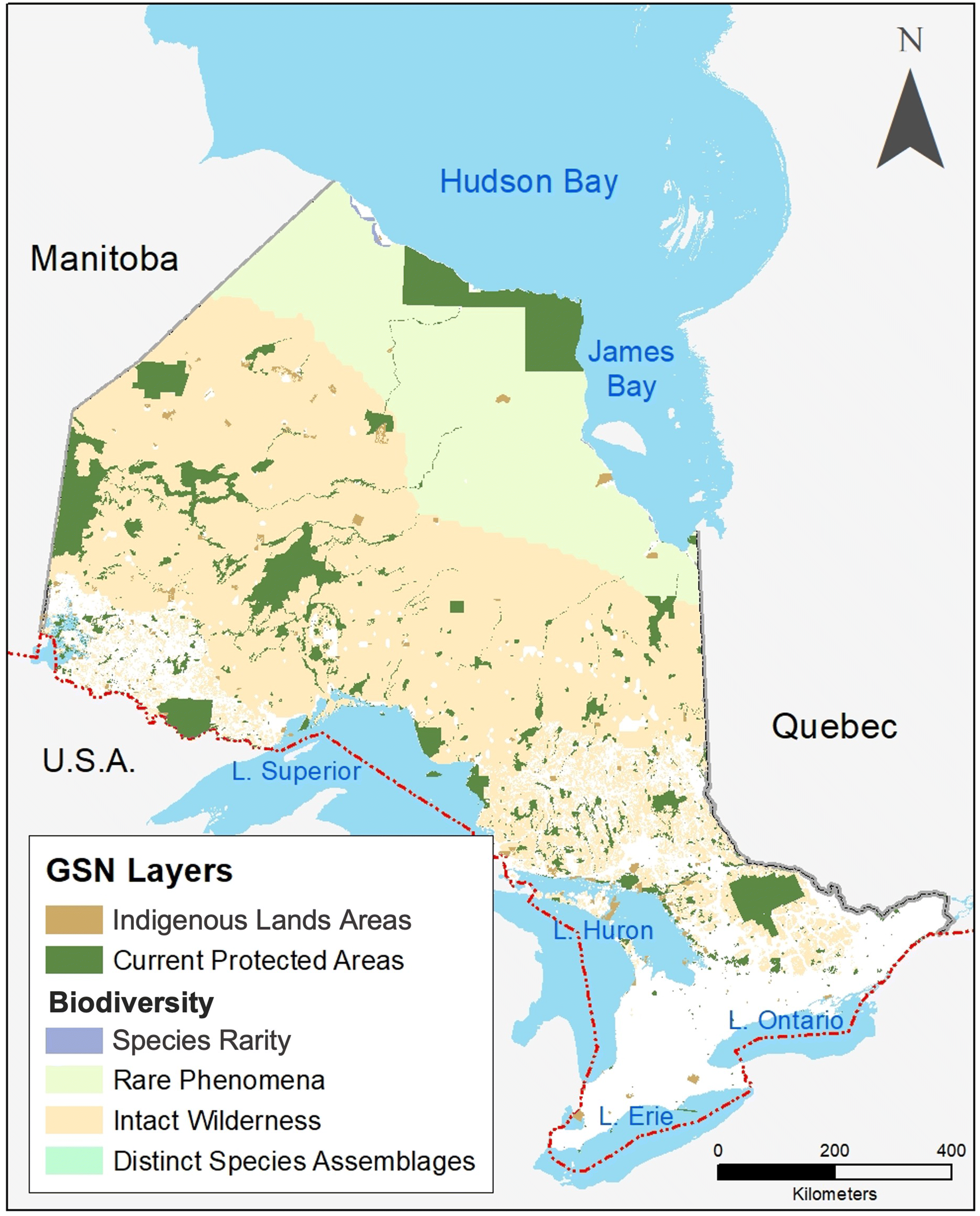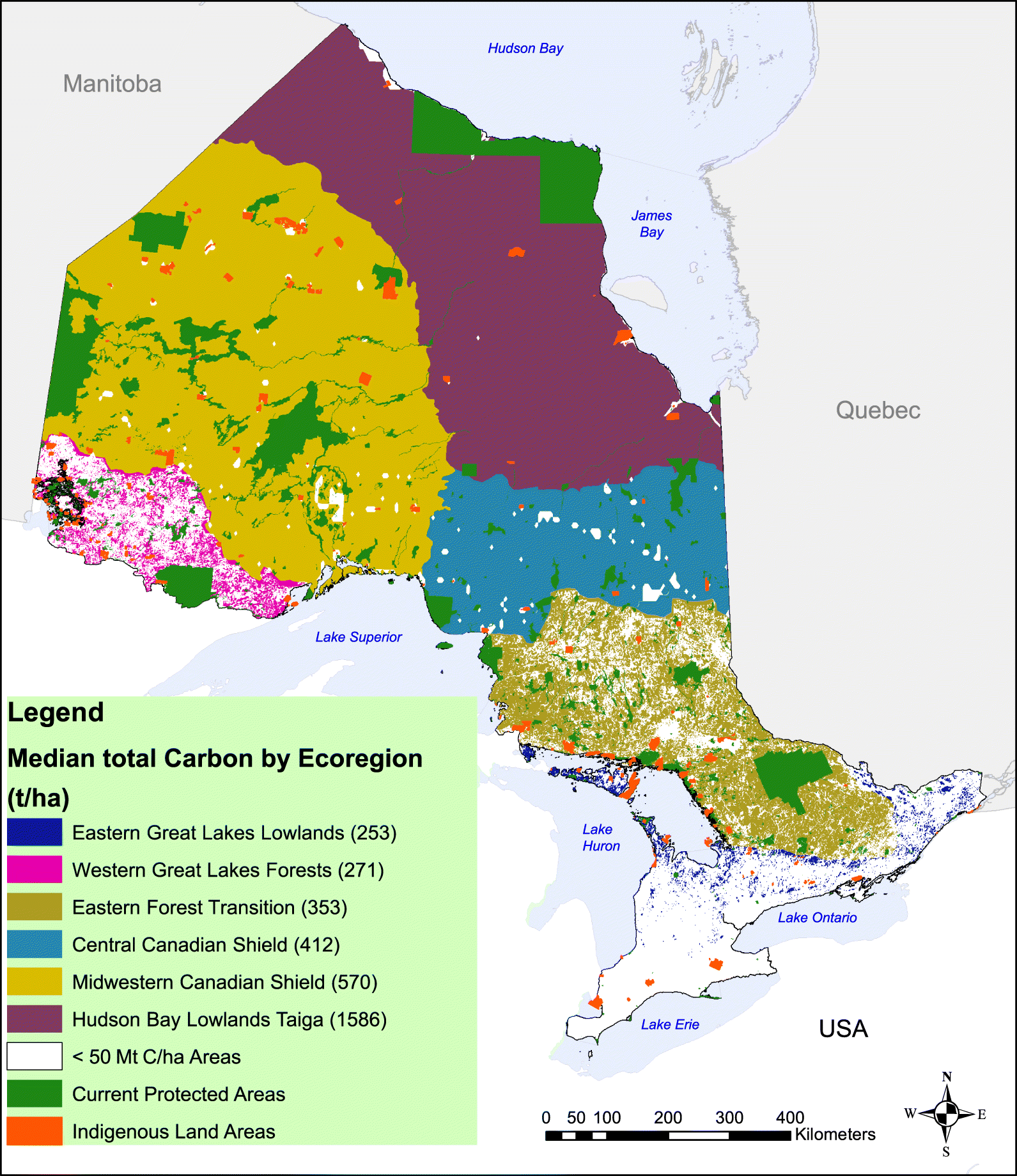Introduction
The Global Safety Net (GSN) is a framework specifying terrestrial regions across the globe that must be protected to simultaneously prevent carbon losses from land use in support of the UNFCCC Paris Agreement aiming to limit warming to no more than 1.5–2.0 °C and to prevent further catastrophic biodiversity losses (
Dinerstein et al. 2020). The GSN is one implementation of the “half-earth” philosophy (
Wilson 2016), which holds that 50% of Earth’s land surface must be protected to ensure the viability of remaining species (
Dinerstein et al. 2019). The GSN initially identifies targets for protection based on four sequential criteria relating to biodiversity: (
i) species rarity, (
ii) turnover or beta diversity, (
iii) the presence of rare ecological phenomena (landscapes containing large mammals), and (
iv) intactness. The GSN then identifies “Tier 1” climate stabilization areas with carbon contents (mass per unit area) above the median for the sum of above- and below-ground plant biomass, and soil carbon, in global terrestrial ecoregions (215 metric tons of carbon per hectare, hereafter “t/ha”). The GSN builds upon the previous framework of
Dinerstein et al. (2019), as well as
Soto-Navarro et al. (2020), and identifies target lands for protection that are non-agricultural and have a low density of human settlement. The GSN also highlights the congruence of target regions with existing protected areas and Indigenous managed lands, which corroborates several other analyses that show the outsized role Indigenous communities have had in protecting vital ecosystem functions including carbon sequestration and biodiversity (
O’Bryan et al. 2021;
Schuster et al. 2019;
Townsend et al. 2020).
In Canada, there is a high demand to protect terrestrial and marine areas of ecological or cultural importance. At the end of 2021, Canada had conserved ∼14% of terrestrial areas (land and freshwater) and ∼14% of marine areas and now aims to increase that to 25% of land and 25% of oceans by 2025, and 30% of each by 2030 (
Environment and Climate Change Canada 2021). The global maps resulting from the GSN analysis (
Dinerstein et al. 2020) indicate that large areas of the Province of Ontario in Canada are highly significant. While it has long been known that Ontario’s boreal and northern peatlands are important globally in terms of carbon stocks and climate stabilization (
Harris et al. 2021;
Holmquist and MacDonald 2014;
Packalen et al. 2014;
Söthe et al. 2022;
Tarnocai et al. 2011), as well as biodiversity (
Abraham et al. 2011;
Far North Science Advisory Panel 2010;
Southee et al. 2021), the GSN strongly highlights the overlap between the areas classified as important in terms of carbon stocks and the biodiversity criteria. Overlays of existing protected areas show that most of the high priority areas highlighted for Ontario are not formally protected from anthropogenic impacts, suggesting an urgent need for increased awareness of the great importance of Ontario’s lands in mitigating the global crises of climate change and catastrophic biodiversity losses. This is especially critical given the high pressures that currently exist in Ontario for developing unprotected areas, especially those in the Far North which are being contested for resource extraction. Furthermore, large areas of Ontario’s Far North are traditional lands of Mushkegowuk Cree and Anishinaabe Nations included in the James Bay Treaty Lands subject to Treaty No. 9 (
Long 2010). Yet, much of these traditional lands (
Native Land Digital 2022) are subject to ongoing land use, land claims, and negotiations for treaty rights, and the “Indigenous lands” mapped for Ontario and Canada more broadly (e.g.,
Garnett et al. (2018)) only include those officially recognized by the Government of Canada (
Natural Resources Canada 2017). The large discrepancy between the extent of formally recognized Indigenous lands and lands that are actually used and are part of traditional territories limits recognition of the significance of past and present management and conservation efforts by Ontario’s First Nations (
Artelle et al. 2019).
While there are important regions across all of Ontario in terms of carbon stocks and biodiversity, the Far North of the province stands out as particularly significant in the GSN and other global-scale analyses (
Soto-Navarro et al. 2020), because of both enormous peatland carbon stocks and roadless areas providing significant wildlife habitat. However, the northern part of Ontario is considered “unmanaged” due to a lack of formal land-use plans, and the extent of formally recognized protected areas is limited (
Fig. 1). Although Ontario’s Far North Act enacted in 2010 specified the need to preserve soil carbon stocks and capacity for carbon sequestration in land-use planning decisions, pressures to accelerate road development, mining, and hydroelectric infrastructure in northern Ontario are continuing to intensify. These development proposals have been politically contentious, and the First Nations Chiefs of the Mushkegowuk Council released a statement in 2021 calling for a moratorium on development in the Far North until comprehensive studies are available on the impacts to wetlands if development proceeds, particularly in terms of existing carbon stocks and potential for uptake (
Baiguzhiyeva 2021).
The GSN is a “top-down” effort to provide objective criteria for prioritizing lands for protection and is intended as a dynamic tool to support land-use planning at national or subnational scales (
Dinerstein et al. 2020). With the goal of contributing to the discussion on expanding protection and protected areas in Ontario, we aim here to (
i) highlight the areas identified in the GSN as targets for protection in Ontario, (
ii) critically analyze the data for Ontario used to delineate these targets in the analyses of
Dinerstein et al. (2020), (
iii) highlight data needs for assessing the capacity for climate stabilization and biodiversity conservation in Ontario, and (
iv) comment on applicability of GSN criteria to conservation planning for Ontario.
Conclusions and recommendations
The GSN framework is global in scale and relies considerably on large intact wilderness areas in the boreal biome to achieve the target of 50% of protected global lands. There are many compelling reasons to protect large swaths of roadless boreal forest and peatlands; however, the GSN framework when scaled down to a jurisdiction such as Ontario has limitations in terms of identifying specific areas to prioritize for conservation and also discounts the opportunities for biodiversity conservation and climate stabilization in less intact regions. Despite these limitations, the GSN results for Ontario highlight the global significance of its conservation decisions.
Dinerstein et al. (2020) call for leadership from local jurisdictions and we urge Ontario to enhance protection for lands that are critical to climate stabilization and the protection of biodiversity. Ontario stewards one of the largest natural carbon stocks globally, because of the abundant peatlands and boreal forests of the Far North. Ontario is also a key area for the biodiversity criteria used in the GSN, namely the extensive lands scoring high on “intactness” in the northern half of the province. The large overlap between lands identified for biodiversity as well as climate stabilization in the GSN highlights important opportunities for protected areas in Ontario, particularly in the Far North. These lands also correspond to the traditional territories of the Mushkegowuk and Matawa Nations, which have been stewarding these vast “intact” ecosystems for thousands of years. The formally recognized extent of Indigenous lands in Ontario does not reflect actual traditional territories and is greatly limited in terms of overlap with lands supporting vital wildlife habitat and significant carbon stocks. This has contributed to the inadequate consultation and representation of First Nations, Métis, and Inuit in national conservation planning.
Our analysis of GSN data as applied to Ontario results in several recommendations. In terms of biodiversity, we support previous work showing the importance of broadening criteria for identifying protected areas, including freshwater and marine ecosystems (
Southee et al. 2021), and the need to identify areas of species rarity and high beta-diversity or species turnover along environmental gradients in Ontario. On the carbon side, our recommendations include further developing high-resolution spatial representations of both carbon stocks and sinks, with a focus on soils and peatlands for northern Ontario ecoregions. Additionally, more work is needed to quantify the vulnerability of biodiversity and existing carbon stocks and sinks to climate warming and increasing risk of wildfire, as well as land-use change, road development, and resource extraction. Owing to the complexity of land use and conservation planning in these regions, it is imperative that treaty rights are respected, and First Nations have the opportunity to make decisions regarding land use on their traditional lands.



